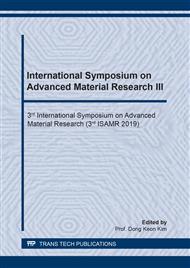[1]
T. Sirijan, K. Thummanukitcharoen, J. Kerdsiri, P. Gaeonaun, N. Yongvanich, Crystallization of Willemite Phase in Ceramic Glaze, Integrated Ferroelectrics – Int. J. 156(1) (2014) 67-71.
DOI: 10.1080/10584587.2014.906284
Google Scholar
[2]
M. G. Rasteiro, T. Gassman, R. Santos, E. Antunes, Crystalline phase characterization of glass-ceramic glazes, Ceram. Int. 33(3) (2007) 345-354.
DOI: 10.1016/j.ceramint.2005.10.002
Google Scholar
[3]
V.Q. Le, M.Q. Do,M.D. Hoang, T.P. Dang, T.H. Bui, H.T. Nguyen, Evaluation on Roles of Activated Silicon and Aluminum Oxides for Formation of Geopolymer from Red Mud and Silica Fume, Key Engineering Materials 777 (2018) 513-517.
DOI: 10.4028/www.scientific.net/kem.777.513
Google Scholar
[4]
G. Rosales – Sosa, T. Poirier, J. Lira-Olivares, J. B Carda-Castelló, Effect of Fluxing Additives in Iron – rich Frits and Glazes in the Fe2O3 – SiO2 – CaO – Al2O3 System, Int. Ceram. Rev. 2(2) (2013) 126-130.
Google Scholar
[5]
N. Yongvanich, T. Sirijan, P. Larpweechai, L. ChatXhatchawong, Reduction of maturation point in crystallie glaze through frit addition, Monatsh Chem. 148 (2017) 1329-1335.
DOI: 10.1007/s00706-017-1991-z
Google Scholar
[6]
H.T. Nguyen, T.N. Le, V.T.H.Q. Pham, T.P. Dang, T.K. Dao, V.P. Nguyen, Development of heat resistant geopolymer-based materials from red mud and rice husk ash, AIP Conference Proceedings 1954 (1) (2018) 040005.
DOI: 10.1063/1.5033414
Google Scholar
[7]
T. Sirijan, K. Thummanukitcharoen, J. Kerdsiri, Crystallization of willemite phase in ceramic glaze - Integrated, J. Integrated Ferroelectrics: Int. J. 156(1) (2014) 67-71.
DOI: 10.1080/10584587.2014.906284
Google Scholar
[8]
Tabriziana, B. Eftekhari Yektaa, M. Korda, Crystallization Behaviour of Willemite Crystalline Glazes in Presence of NiO, TiO2 and Fe2O3, Trans. Ind. Ceram. Soc. 73(1) (2014) 43-47.
Google Scholar
[9]
A. R. Jamaludin, S. R. Kasim, Z. A. Ahmad, The effect of CaCO3 Addition on Physical Properties of ZnO-based Crystal Glaze, Adv. Mater. Res. 620 (2013) 12-16.
DOI: 10.4028/www.scientific.net/amr.620.12
Google Scholar
[10]
A. R. Jamaludin, S. R. Kasim, Z. A. Ahmad, The effect of CaCO3 Addition on Physical Properties of ZnO-based Crystal Glaze, Adv. Mater. Res. 620 (2013) 12-16.
DOI: 10.4028/www.scientific.net/amr.620.12
Google Scholar
[11]
C. Y. Lee, H. U. Lee, K. H. Shin, Effects of ZrO2 on Zinc Crystalline Glaze, Adv. Mater. Res. 716 (2013) 228-234.
Google Scholar
[12]
H.T. Nguyen, Evaluation on Formation of Aluminosilicate Network in Ternary-Blended Geopolymer Using Infrared Spectroscopy, Solid State Phenomena 296 (2019) 99-104.
DOI: 10.4028/www.scientific.net/ssp.296.99
Google Scholar
[13]
H.T. Nguyen, Synthesis and Characteristics of Inorganic Polymer Materials Geopolymerized from Ash of Brickyard, Materials Science Forum 961(2019) 45-50.
DOI: 10.4028/www.scientific.net/msf.961.45
Google Scholar
[14]
K. Pekkan, The thermal and microstructural behavior of a R2O–RO–(ZnO)–Al2O3–(TiO2)–SiO2 based macro-crystalline raw glaze system, Ceram. Int. 41(6) (2015) 7881-7889.
DOI: 10.1016/j.ceramint.2015.02.126
Google Scholar
[15]
El-Shennawi, A. A. Omar, A. M. Morsy - The role of titania and titania mixtures in the nucleation and crystallization of spodumene-willemite-diopside glasses, Thermochimica Acta, 58(2) (1982) 125-153.
DOI: 10.1016/0040-6031(82)87077-9
Google Scholar
[16]
V.Q. Le, M.Q. Do,M.D. Hoang, V.T.H.Q. Pham, H.T. Nguyen, Effect of Alkaline Activators to Engineering Properties of Geopolymer-Based Materials Synthesized from Red Mud, Key Engineering Materials 777 (2018) 508-512.
DOI: 10.4028/www.scientific.net/kem.777.508
Google Scholar
[17]
Q.M. Do, T.H. Bui, H.T. Nguyen, Effects of Seawater Content in Alkaline Activators to Engineering Properties of Fly Ash-Based Geopolymer Concrete, Solid State Phenomena 296 (2019) 105-111.
DOI: 10.4028/www.scientific.net/ssp.296.105
Google Scholar
[18]
H. T. Nguyen, H.L.N. Nguyen, T.N.U. Vo, T.K. Pham, Novel Materials Synthesized from Red Mud, Bagasse, and Bentonite for Gas Treatment by CO2 Absorption, MATEC Web of Conferences 207 (2019) 03005.
DOI: 10.1051/matecconf/201820703005
Google Scholar


